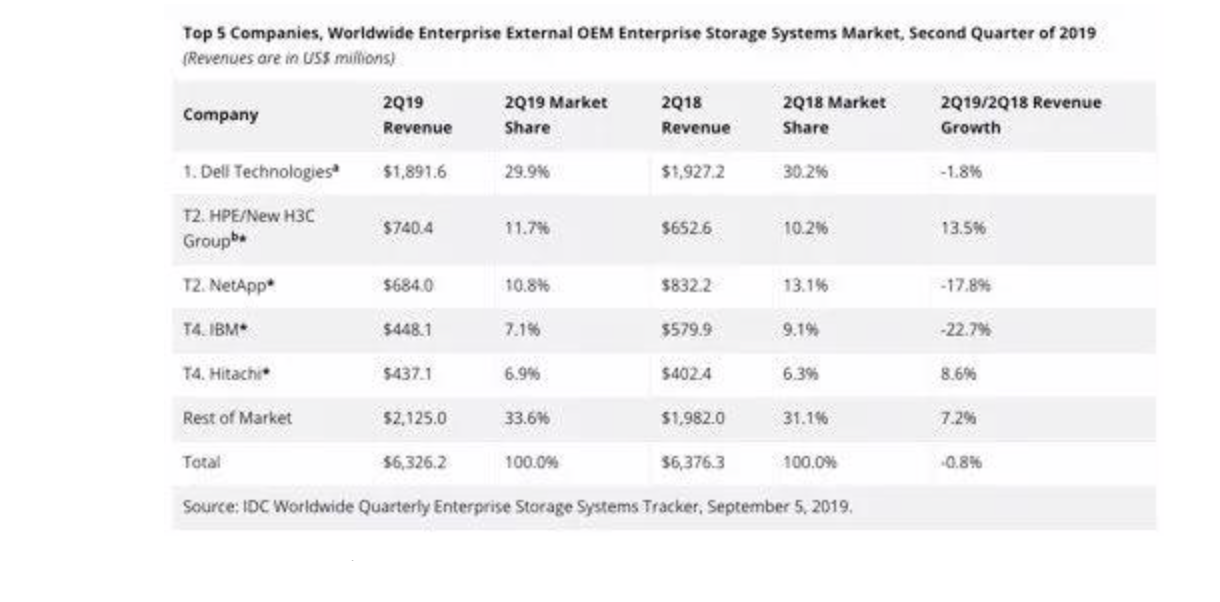Published :11/12/2019 8:43:58 PM
Click Count:2103
IDC's global enterprise storage systems market report for the second quarter of this year showed that the global external storage market fell by 0.8% year-on-year. In fact, the global enterprise storage market has been relatively stable in 2019, and even has seen a slight decline. Even the high-growth products such as all-flash arrays have experienced a slowdown in growth. What changes will happen to the global enterprise storage market in the future?

Recently, Chris Mellor, a well-known storage journalist, interviewed GigaOm storage analyst Enrico Signoretti, who talked about his current state of the art storage market. The viewpoint is refined as follows:
1. The main storage market will be integrated, leaving only a few suppliers to become major players in the market.
2, NetApp, Hitachi and other companies are expanding their technology stacks, moving closer to cloud and big data, and their main storage business will not grow significantly in the future.
3. The secondary storage market is not going to integrate like the main storage, and many startups have the hope of breaking the market.
4, the primary storage vendor will pay more attention to the efficiency of the overall stack, as well as the future financial approach to subscriptions like cloud services.
5. The role of secondary participants in the market over time will be insignificant.
6. Storage hardware is no longer important. Hybrid cloud, data management, and data analysis are the future solutions for storage vendors.
Q: Can you describe the market structure of some IT industry suppliers such as disk, tape library, public cloud and fiber switch?
A: This generally occurs as the market matures and occurs in every industry. In the case of airplanes, the market has undergone large-scale integration over the past 30 years. There are currently only two major product lines in the market for major players in 1:1 competition and some niche market participants. In addition to tape, switches, and HBAs, I think primary storage will move toward this.
Q: If the mature areas of the IT industry eventually merge into only two or three major players, is it possible to have the same pattern in primary storage?
A: This sign already exists, it started a few years ago and will accelerate in the next two years. For example, consider Hitachi Data Systems. Their product lineup has shrunk, and now they actually have only two storage products (VSP 5000 and HCP). They strategically chose to focus on these higher stacks for IoT, data management and big data analytics, and storage is now critical to their overall strategy. And, as far as I know, it is paying off. Their products are still top notch, but you won't see any significant increase in market share. NetApp is another good example. With its Data Fabric vision, it is pursuing a similar strategy, but with the goal of providing choices for data mobility and management across on-premise and cloud.
Q: Will the same trend occur in the areas of secondary storage, data management software and data protection, or will the general storage vendors be merged?
A: Currently, secondary storage is another matter. A lot has happened in this area, and new startups (such as Cohesity, etc.) are really breaking the market, re-emphasizing object storage (performance, data management functions, etc.); the new innovative horizontally scaled file system has also attracted a lot of attention. The market is very active and most solutions are well suited for most organizations' hybrid cloud and machine learning programs.
Q: What are the main players in the main array storage market after integration? What product features and business models will it have?
A: A few of the remaining major players in the market will have a broad product lineup that covers most use cases. They will pay more attention to the efficiency of the overall stack than the features. Financial aspects will also be more important than a single function, and everyone is studying these cloud-like consumption models. It doesn't work for all end users, but as long as you accept access to availability, SLA, capacity, and IOPS permissions, rather than managing it at first, the technical details about how the vendor operates will become less relevant. . After all, if you can get what you want, you don't really care how Microsoft, Google or Amazon run its cloud. Moreover, if storage vendors want to replicate the same experience locally, they will also have to accept such results.
Q: What happens to existing suppliers that are not destined to be major players in the future market? Should they actively seek acquisitions?
A: It’s hard to answer. In any case, some suppliers will have to face this problem. We are here to talk about enterprise storage. But if business shrinks and profits fall, will they sell the business to companies that can support end users? Or are some Chinese manufacturers involved to improve production and sales processes? Selling individual products (and teams) one by one? I am sure that for these suppliers, this will be an opportunistic approach.
Q: In the worst case, what happens to the secondary suppliers that have not acquired?
A: They may become niche market participants or they will become irrelevant over time.
Q: Should the supplier realistically assess its status and possible end points and develop a proactive strategy to capture or avoid it? By entering the non-integrated part of the storage industry?
A: 2020 and 2021 are critical to the future of the industry. As I said, some vendors have begun to assess their status and are beginning to look at how to make them more relevant to customers and move the technology stack up. They are actively researching hybrid clouds, data management and governance, analytics, and more. It can be said that the storage hardware is less and less connected.